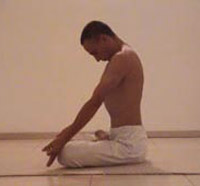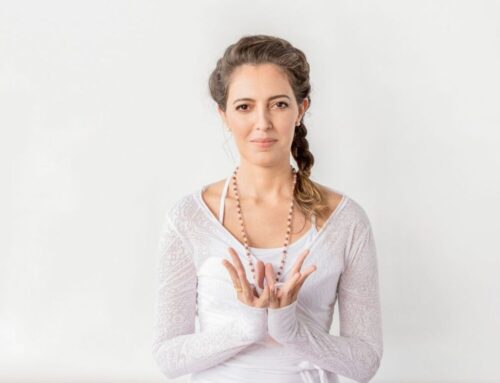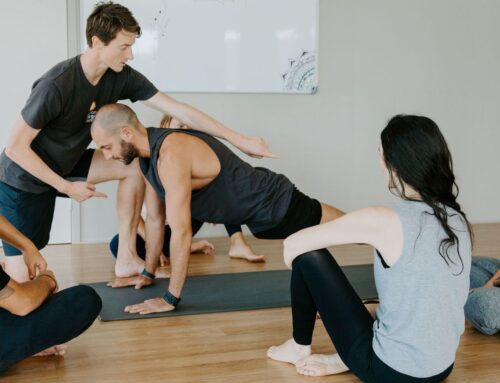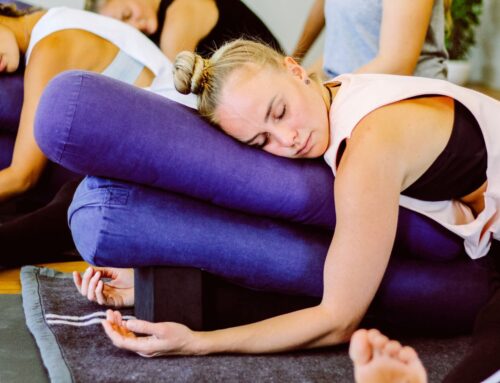Written by Kara Goodsell
‘Engage Mula Bandha’ is an oft-quoted instruction in class. But just how do you do that? Byron Yoga Centre teacher trainer Kara Goodsell explores some simple techniques and tips for isolating and engaging your three main bandhas to help take your asana and meditation practice to the next level.
For a more general understanding of the bandhas, read our previous article where we discussed the concept and benefits of engaging your bandhas.
To activate Jalandhara Bandha (throat lock, translates as ‘web’ or ‘net’ lock)
• Sit in a comfortable cross-legged position (Sukhasana) or with the right heel in toward the perineum (Siddasana). Anchor down through the sit bones and create length in the spine;
• You may prefer to lie on your back either flat on the floor, or on top of a bolster placed one wide hands-distance away from the buttocks, running lengthways in line with the spine. If there is any lower back discomfort, place a bolster or rolled blanket underneath the knees. Should you find your chin tilting away from the body towards the ceiling, support the head with a folded blanket;
• Swallow to open the throat. Tilt the chin in toward the notch between the collar bones. Relax the throat as the back of the neck lengthens and the chin releases downwards. See if you can smile in the back of the throat;
• You can also contract your throat by either opening the mouth and breathing in and out or talking in a whisper – observe the movement of the glottis or respiratory passage in the throat as the folds partially close– then close the mouth and continue breathing;
• Become aware of the soft hissing sound of the breath and the gentle rise and fall of the abdomen. The pitch and, to some extent, the length of the sound you make is determined by the amount of tension in the throat so keep the sound soft and gentle.
To activate Mula Bandha (root lock, translates as ‘foundation’ or ‘origin’ lock)
• At the end of an inhalation, lift your perineum in towards your spine and up towards the diaphragm. The action is similar to lifting the muscles around your anus and vagina, as if trying to stop passing wind and urine at the same time. For males, the action is similar to drawing the testicles in toward the body. If the above actions were described as a rate of 10/10 lift, then the lift of Mula Bandha is far more subtle, at a rate of 4-5/10;
• Be aware not to compensate by squeezing the legs together or tightening the buttocks;
• Continue to maintain the lift on the exhalation and hold for five cycles of inbreath/outbreath before releasing;
• Keep Mula Bandha released for five cycles of breath before again practicing the action of drawing up the perineum.
When you feel that you have an awareness of the actions of Jalandhara Bandha and Mula Bandha, you are ready to introduce Uddiyana Bandha.
To activate Uddiyana Bandha (abdominal lock, translates as ‘flying up’ lock)
• Inhale deeply and then exhale quickly so that the air rushes out of your lungs. After expelling all your breath, pull the entire abdominal region back towards the spine, drawing the navel inwards and upwards, as if to draw up the belly underneath the rib cage;
• Inhale and exhale while maintaining the lift and with each inhalation begin directing the breath into the side ribs and chest. Hold for five cycles of breath before releasing.
Between each cycle of holding the bandhas for five breath cycles, release for five breath cycles, increasing your number of breath cycles over time as your practice develops. It is best to practice using your bandhas on an empty stomach. If there is any strain around the temples, tightness across the forehead or chest or if the breath is laboured, this means that you are practicing beyond your capacity and the force of your breath should be lessened.
Keep your breath regular and even throughout your practice, as an even breath leads to an even mind. It is recommended to avoid activating Mula Bandha and Uddiyana Bandha during menstruation and if you are pregnant, avoid Uddiyana Bandha and any work with the bandhas that involves holding the breath.
Consciously introducing the bandhas into your asana practice will help protect you from injury by redistributing mechanical stress in the body, thereby creating greater stability. Engaging your bandhas also gives length and texture to the breath.
Over time, the action of your bandhas begins to transcend the muscles and becomes more subtle, working in your energetic realm. Ultimately, cultivating greater engagement of your bandhas will help unite the three aspects of your mind – the individual mind (manas), reason (buddhi) and ego (ahamkara) – into the total mind of chitta, where fluctuations will cease and peace will be realised.
References
Light on Pranayama – The Yogic Art of Breathing, B.K.S. Iyengar
Yoga Anatomy, Leslie Kaminoff.
Related articles






